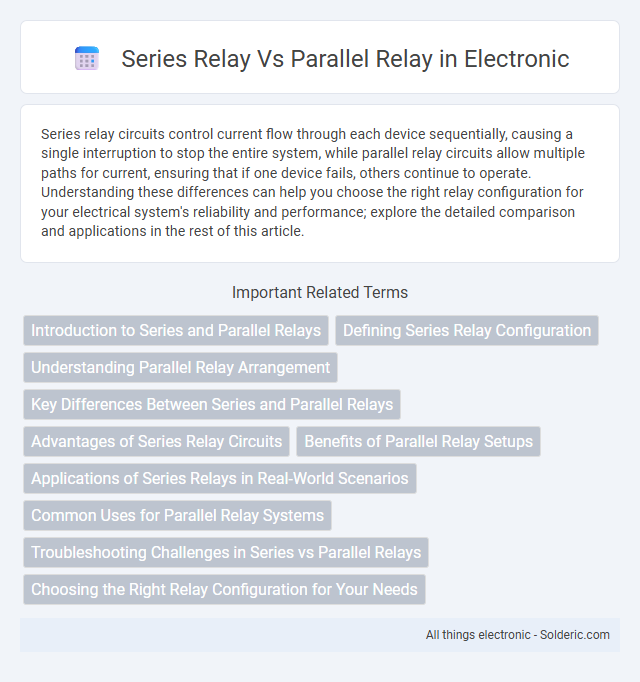Series relay circuits control current flow through each device sequentially, causing a single interruption to stop the entire system, while parallel relay circuits allow multiple paths for current, ensuring that if one device fails, others continue to operate. Understanding these differences can help you choose the right relay configuration for your electrical system's reliability and performance; explore the detailed comparison and applications in the rest of this article.
Comparison Table
| Feature | Series Relay | Parallel Relay |
|---|---|---|
| Connection Type | Connected in series with the load | Connected in parallel with the load |
| Current Flow | Same current flows through relay and load | Relay and load draw current independently |
| Voltage Drop | Significant voltage drop across relay | Minimal voltage drop across relay |
| Isolation | No electrical isolation between relay and load | Provides electrical isolation |
| Use Case | Overcurrent protection, current sensing | Control circuits, switching applications |
| Fault Impact | Failure affects entire circuit operation | Failure does not necessarily interrupt load |
| Complexity | Simple wiring but affects load current | More complex wiring, independent operation |
Introduction to Series and Parallel Relays
Series relays are connected sequentially in a circuit so that the same current flows through each relay coil, enabling control over multiple devices with a single control signal but causing the entire circuit to stop if one relay fails. Parallel relays are wired simultaneously across the power source, allowing each relay to operate independently, which ensures that the failure of one relay does not interrupt the operation of others. Your choice between series and parallel relay configurations depends on the desired control complexity, reliability requirements, and specific application needs.
Defining Series Relay Configuration
A series relay configuration connects multiple relay coils end-to-end, allowing the same current to flow through each coil sequentially. This setup ensures that all relays must be energized simultaneously for the circuit to complete, providing precise control in protection schemes. Series relay configurations are commonly used in applications requiring coordinated tripping actions across multiple devices.
Understanding Parallel Relay Arrangement
In a parallel relay arrangement, multiple relays are connected side by side, allowing the current to split and flow through each relay independently, enhancing system reliability by reducing the likelihood of total circuit failure. This setup provides better voltage stability across devices and ensures that if one relay fails, the others can continue to operate without interruption. Understanding this configuration helps you design circuits that maintain functionality and safety under varying electrical loads and fault conditions.
Key Differences Between Series and Parallel Relays
Series relays are connected sequentially, causing the current to flow through each relay one after another, which results in a shared current but increased total resistance and voltage drop. Parallel relays are connected across the same voltage source, allowing each relay to operate independently with the same voltage but divided current, ensuring that if one relay fails, others remain functional. The key differences include current flow configuration, voltage distribution, and impact on circuit reliability and load handling capacity.
Advantages of Series Relay Circuits
Series relay circuits offer improved fault detection since any break in the series path immediately interrupts the current flow, enhancing the system's safety and reliability. They require fewer components and wiring compared to parallel circuits, leading to simplified installation and reduced maintenance costs. Your control systems benefit from precise current monitoring in series relay configurations, enabling efficient and responsive operation in critical applications.
Benefits of Parallel Relay Setups
Parallel relay setups offer enhanced reliability by ensuring that if one relay fails, others can continue to operate without interrupting the entire circuit. This configuration improves current distribution, reducing the load on each relay and preventing overheating, which extends the lifespan of your components. Utilizing parallel relays also allows for easier maintenance and scalability in complex electrical systems.
Applications of Series Relays in Real-World Scenarios
Series relays are commonly used in protection circuits for electrical transformers and motors, where they detect and isolate faults by monitoring current flow. Their design ensures that the relay trips only when the current exceeds a certain threshold, making them ideal for overload and short-circuit protection in industrial machinery. You can find series relays applied in real-world scenarios such as power distribution systems, ensuring safety by interrupting circuits during abnormal conditions.
Common Uses for Parallel Relay Systems
Parallel relay systems are commonly used in industrial automation for controlling multiple circuits independently, ensuring that a failure in one relay does not affect the operation of others. These systems provide enhanced reliability in critical applications such as power distribution panels and motor control centers, where simultaneous control and fault isolation are crucial. Your setup benefits from parallel relays by improving operational flexibility and simplifying maintenance procedures.
Troubleshooting Challenges in Series vs Parallel Relays
Troubleshooting challenges in series relays often involve difficulty in identifying the exact point of failure since a fault in any single relay can disrupt the entire circuit, causing the entire series to malfunction. In contrast, parallel relays provide easier fault isolation because each relay operates independently, allowing technicians to test and replace defective units without affecting the overall circuit functionality. Series relay systems require careful voltage drop analysis, while parallel configurations demand checking individual current paths for accurate diagnosis.
Choosing the Right Relay Configuration for Your Needs
Choosing the right relay configuration depends on your circuit requirements and desired control. Series relays provide sequential control, ideal for applications that require multiple conditions to be met before activation, while parallel relays allow independent operation for redundancy and increased reliability. Understanding the current load, voltage levels, and switching logic helps optimize performance and prevent circuit failure.
Series Relay vs Parallel Relay Infographic

 solderic.com
solderic.com